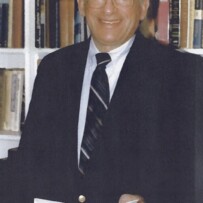Rievan W. Slavkin

Rabbi Slavkin received a Bachelor of Arts degree from the University of Pittsburgh (1957) and a Masters in Marriage and Family Counseling from Hofstra University (1987). In addition to his Ordination diploma, he also received a Bachelor (1959) and Masters (1962) degrees in Hebrew Letters from the College-Institute. He was awarded an honorary Doctor of Hebrew Letters Degree (1987).
Two congregations provided memorable experiences for Rabbi Slavkin. Temple Beth Israel (1964 – 1970) in Jackson, Michigan, was one of the congregations that Rabbi Isaac Mayer Wise, the founder of American Reform Judaism, visited in 1864. He urged the congregation to be worthy representatives of their Judaism. This congregation had already compiled a century of such experiences. Rabbi Slavkin and his congregation continued this tradition.
The Jackson rabbi was also the Jewish Chaplain of the Michigan State Department of Corrections. This part-time responsibility opened new areas of rabbinic responsibilities for Rabbi Slavkin as he brought Judaism into the walled prison housing more than 5000 inmates.
While serving Sinai Reform Temple, Bay Shore, NY, Rabbi Slavkin fulfilled the requirements of a graduate course, Marriage and Family Counseling at Hofstra University (1984 – 1987). The course defined a systems approach with classroom requirements applied to counseling experience in a family agency. The temple leadership offer end much encouragement; some congregants even provided information for anonymous case study homework assignments. Much of this counseling experience was needed when a fire destroyed the entire sanctuary building in November, 1990.
As dawn slowly identified those drawn to the site, Rabbi Slavkin’s clergy friends were standing with him. The Monsignor of the town’s Catholic Church said, “You and your people are our brothers and sisters. We have a building. It’s yours for as long as you need it.” Later that afternoon a former temple president who chaired the rebuilding committee and the rabbi met. Both agreed to keep engaged as many congregants as possible. During the next 34 months many stepped forward. The response from the community also was a source of strength. Every contribution was acknowledged. From synagogues, from churches, from friends and strangers; “We knew we were not alone. So many were helping us re-build;” Rabbi Slavkin acknowledged at the Dedication Chanukah Service in December, 1993.
One of the letters received during the rebuilding years asked the rabbi to read Jacob Riis who praised the stone mason who carefully crafts the rock into its final form.
Before he retired the rabbi wrote: “I try to remember the patient stone mason. To my sermons, in my class rooms and in counseling sessions there are those who do not respond. But then, something happens. Some do respond who for weeks were silent.
I remember the stone mason and am grateful to have shared his experience.
